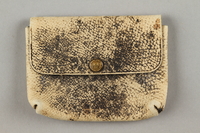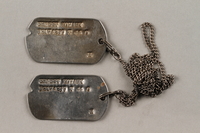Overview
- Brief Narrative
- Red leather notebook that belonged to Tom (Tibor) Kovary. On September 2, 1939, nineteen year old Tibor Kovari and his twenty year old brother, Erno, were attacked on the street for being Jewish by Nazi sympathizers in their hometown, Bratislava, Czechoslovakia (Slovakia). They fought back, put their attackers in the hospital, and were arrested, along with their father, Olivio. The incident received such widespread publicity that the authorities advised them to flee for fear of retaliation. They illegally crossed the border into Hungary, where they obtained visas for the US, arriving in New York on February 29, 1940. Both brothers joined the US Army: Tom was in Military Intelligence stateside; Ernest in combat, landing with the infantry on D-Day. He searched for surviving relatives, but found only one cousin, a survivor of Auschwitz death camp.
- Date
-
emigration:
1940 February
- Credit Line
- United States Holocaust Memorial Museum Collection, Gift of Myra Kovary and Vally Kovary.
- Contributor
-
Subject:
Tom T. Kovary
- Biography
-
Tom Kovary was born as Tibor Kövári on June 23, 1920, in Bratislava, Czechoslovakia. Tom’s parents were Olivio and Esther Fuchs Kövári. He joined his one year old brother, Ernö (Ernest), born April 2, 1919. Tom’s parents spoke Esperanto at home and taught this to their children as their mother tongue. Tom and Ernest were the first native Esperanto speakers in the world. Their other native languages were German, Hungarian, and Slovak. The brothers were extremely athletic and belonged to the Bar Kochba Jewish Sports Club. They were national champions in gymnastics and wrestling.
Their father, Olivio, was born in Baltimore, Maryland, on November, 4, 1890. His parents, Alexander and Josefine Berkovits Kovari, arrived in the US in early 1890. Olivio’s birth was never properly registered. The family returned to their hometown of Galanta in the Austro-Hungarian Empire, because Josephine was ill. She died soon after; Alexander remarried and did not return to the US. Gaining recognition of his status as a US citizen was a consuming passion for Olivio; he finally achieved this recognition in 1949. Olivio tried to emigrate to the United States in the early 1930s, but the United States did not recognize his citizenship. As part of the preparation for their imminent emigration, Olivio pulled the boys out of school, in 1934, to teach them the fur trade. But the US response remained negative. Tom and Ernest returned to school and Tom graduated from a vocational school in Bratislava in 1937. However, his father did officially register their desire to emigrate with the US consulate in 1936, a fact that would aid them in their flight from Czechoslovakia in a few years.
On September 2, 1939, Tom and Ernest got into a fight with two Nazi sympathizers on the street in Bratislava. This landed the Nazi sympathizers in the hospital and Tom and Ernest were arrested, along with their father. This was an internationally publicized instance of Jewish resistance; it was even broadcast on the BBC. Widespread street fighting and vandalism followed and the Kovary store was broken into and looted. The district attorney and the head of the prison feared that the boys would be killed by Nazi sympathizers, so they released them in the middle of the night. The Jewish Central Committee assisted with the release and helped the family to go underground. On December 12, 1939, the family crossed illegally into Hungary. They stayed in Budapest until they were able to obtain immigration visas to the United States and transit visas for Yugoslavia and Italy. The Kovary family left Genoa, Italy, on February 20, 1940, on the ship, SS Conte di Savoia. They arrived February 29, 1940, in New York. Upon arrival, they changed their last name to Kovary.
In January 1943, Tom joined the United States Army. He served first in the Quartermasters Corp, but because of his linguistic abilities, was transferred to Military Intelligence. Tom served stateside, chiefly in Louisiana, until he separated from the service in February 1946. Ernest was posted to the European theater and landed at Normandy on D-Day, June 6, 1944. After the war, Ernest, fluent in seven languages, stayed in Europe working as a translator for the US Department of Justice. He searched for surviving relatives, but found only one cousin, Herta Fuchs, who survived Auschwitz death camp.
After the war, Tom attended Ohio State University on the GI Bill of Rights. While there, he met and eventually married Ingrid Neuhaus, a Jewish refugee from Germany. Ingrid was born in Hamburg on August 2, 1921, to Julius and Marie Eisner Neuhaus. She had two siblings, Annelore, born September 23, 1923, and Hans, born July 20, 1925. Her father was a leather merchant and the family was assimilated. In 1933, they joined a synagogue in reaction to the growing anti-Semitism in the city. The two younger children were sent to England on a Kindertransport in January 1939; Ingrid arrived there by ferry in February. Their parents were deported to the Minsk ghetto in Belorussia in November 1941 and murdered there by the Germans in 1942. They married on July 30, 1950, and had two daughters. In 1953, they moved to New York so that Tom could continue his academic studies at Cornell University. In 1959, he became a professor of Spanish and Linguistics at the State University of New York in Cortland, NY, and retired in 1985. He was devout and active in various Jewish organizations throughout his life. Tom died of cancer in 1988, age 68. His mother, Esther, died a few months later at the age of 91. Ingrid, 88, passed away in September 2009.
Physical Details
- Classification
-
Office Equipment and Supplies
- Category
-
Stationery
- Object Type
-
Loose-leaf binders (lcsh)
- Physical Description
- Red leather rectangular flat portfolio that folds in half to enclose interior pockets. The red cloth lined interior has 2 horizontal and 1 vertical pocket on the left side and a notebook with a red cloth cover is glued on the right. On the center of the long open side is a silver colored metal lock with a u-shaped buckle with a key lock. The lock is attached to a red tab, once sewn onto the back of the portfolio, but no longer attached.
- Dimensions
- overall: Height: 10.875 inches (27.623 cm) | Width: 8.625 inches (21.908 cm) | Depth: 1.000 inches (2.54 cm)
- Materials
- overall : leather, cloth, paper, thread, metal, adhesive
Rights & Restrictions
- Conditions on Access
- No restrictions on access
- Conditions on Use
- No restrictions on use
Keywords & Subjects
Administrative Notes
- Legal Status
- Permanent Collection
- Provenance
- The portfolio was donated to the United States Holocaust Memorial Museum in 2009 by Myra and Vally Kovary, the daughters of Tom T. Kovary.
- Record last modified:
- 2023-03-02 08:57:47
- This page:
- https://collections.ushmm.org/search/catalog/irn40043
Also in Kovary and Neuhaus families collection
The Kovary and Neuhaus families collection includes medals, ribbons, pins, a leather wallet, a leather portfolio, a set of silver ice cream spoons, and family papers documenting the Holocaust-era experiences of the Kovary family from Bratislava and the Neuhaus family from Hamburg.
Date: 1890-2013
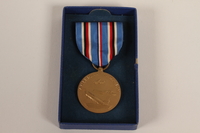
US Army American Campaign Medal and ribbon bar with presentation box awarded to a Czech Jewish refugee
Object
Bronze medal with ribbon, ribbon bar, and presentation box issued to Tom (Tibor) Kovary for service in the United States Army from 1943-1946. On September 2, 1939, 19 year old Tibor Kovari and his 20 year old brother, Erno, were attacked on the street for being Jewish by Nazi sympathizers in their hometown, Bratislava, Czechoslovakia. They fought back, put their attackers in the hospital, and were arrested, along with their father, Olivio. The incident received such widespread publicity that the authorities advised them to flee for fear of retaliation. They illegally crossed the border into Hungary, where they obtained visas for the US, arriving in New York on February 29, 1940. Both brothers joined the US Army: Tom was in Military Intelligence stateside; Ernest in combat, landing with the infantry on D-Day. He searched for surviving relatives, but found only one cousin, a survivor of Auschwitz death camp.
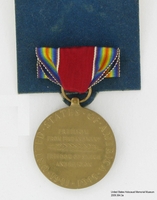
US Army Victory Medal, two ribbon bars and presentation box awarded to a Czech Jewish refugee
Object
Victory Medal, ribbon bars, and box issued to Tom (Tibor) Kovary for service in the United States Army from 1943-1946. On September 2, 1939, nineteen year old Tibor Kovari and his twenty year old brother, Erno, were attacked on the street for being Jewish by Nazi sympathizers in their hometown, Bratislava, Czechoslovakia. They fought back, put their attackers in the hospital, and were arrested, along with their father, Olivio. The incident received such widespread publicity that the authorities advised them to flee for fear of retaliation. They illegally crossed the border into Hungary, where they obtained visas for the US, arriving in New York on February 29, 1940. Both brothers joined the US Army: Tom was in Military Intelligence stateside; Ernest in combat, landing with the infantry on D-Day. He searched for surviving relatives, but found only one cousin, a survivor of Auschwitz death camp.
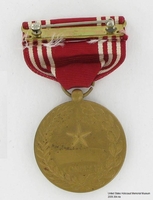
US Army Good Conduct Medal, 3 ribbon bars, and 3 ribbons awarded to a Czech Jewish refugee
Object
Good Conduct Medal, three red and white ribbon bars, and 3 replacement ribbons issued to Tom (Tibor) Kovary for service in the United States Army from 1943-1946. On September 2, 1939, 19 year old Tibor Kovari and his 20 year old brother, Erno, were attacked on the street for being Jewish by Nazi sympathizers in their hometown, Bratislava, Czechoslovakia (Slovakia). They fought back, put their attackers in the hospital, and were arrested, along with their father, Olivio. The incident received such widespread publicity that the authorities advised them to flee for fear of retaliation. They illegally crossed the border into Hungary, where they obtained visas for the US, arriving in New York on February 29, 1940. Both brothers joined the US Army: Tom was in Military Intelligence stateside; Ernest in combat, landing with the infantry on D-Day. He searched for surviving relatives, but found only one cousin, a survivor of Auschwitz death camp.
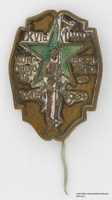
World Congress of Esperanto stickpin with an image of soldier upon a green star owned by a Czech Jewish refugee
Object
Commemorative pin from the World Congress of Esperanto in Vienna, Austria, in 1924, owned by Tom (Tibor) Kovary. On September 2, 1939, nineteen year old Tibor Kovari and his twenty year old brother, Erno, were attacked on the street for being Jewish by Nazi sympathizers in their hometown, Bratislava, Czechoslovakia. They fought back, put their attackers in the hospital, and were arrested, along with their father, Olivio. The incident received such widespread publicity that the authorities advised them to flee for fear of retaliation. They illegally crossed the border into Hungary, where they obtained visas for the US, arriving in New York on February 29, 1940. Both brothers joined the US Army: Tom was in Military Intelligence stateside; Ernest in combat, landing with the infantry on D-Day. He searched for surviving relatives, but found only one cousin, a survivor of Auschwitz death camp.
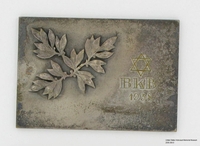
Bar Kochba Jewish Sports Club metal plaque with a Star of David owned by a Czech Jewish refugee
Object
Commemorative plaque from the Bar Kochba Jewish sports club awarded to Tom T. Kovary in Bratislava, Czechoslovakia, on January 9, 1938. On September 2, 1939, nineteen year old Tibor Kovari and his twenty year old brother, Erno, were attacked on the street for being Jewish by Nazi sympathizers in Bratislava. They fought back, put their attackers in the hospital, and were arrested, along with their father, Olivio. The incident received such widespread publicity that the authorities advised them to flee for fear of retaliation. They illegally crossed the border into Hungary, where they obtained visas for the US, arriving in New York on February 29, 1940. Both brothers joined the US Army: Tom was in Military Intelligence stateside; Ernest in combat, landing with the infantry on D-Day. He searched for surviving relatives, but found only one cousin, a survivor of Auschwitz death camp.

Bar Kochba Jewish Sports Club (BKB) stickpin with blue enamel decoration owned by a Czech Jewish refugee
Object
Pin from the Bar Kochba Jewish sports club (BKB) , in Bratislava, Czechoslovakia, received by Tom T. Kovary, prior to emigration. On September 2, 1939, nineteen year old Tibor Kovari and his twenty year old brother, Erno, were attacked on the street for being Jewish by Nazi sympathizers in Bratislava. They fought back, put their attackers in the hospital, and were arrested, along with their father, Olivio. The incident received such widespread publicity that the authorities advised them to flee for fear of retaliation. They illegally crossed the border into Hungary, where they obtained visas for the US, arriving in New York on February 29, 1940. Both brothers joined the US Army: Tom was in Military Intelligence stateside; Ernest in combat, landing with the infantry on D-Day. He searched for surviving relatives, but found only one cousin, a survivor of Auschwitz death camp.
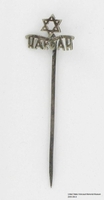
Hakoah Sports Club stickpin with a Star of David owned by a Czech Jewish refugee
Object
Pin from the Hakoah sports club that belonged to Tom T. Kovary, prior to emigration from Bratislava, Czechoslovakia. On September 2, 1939, nineteen year old Tibor Kovari and his 20 year old brother, Erno, were attacked on the street for being Jewish by some Nazi sympathizers in their hometown, Bratislava, Czechoslovakia. They fought back and put their attackers in the hospital and were arrested, along with their father, Olivio. The incident received such widespread publicity that the authorities advised them to flee for fear of retaliation. They illegally crossed the border into Hungary, where they obtained visas for the United States, arriving in New York on February 29, 1940. Both brothers joined the US Army during the war: Tom was in Military Intelligence stateside; Ernest in combat, landing with the infantry on D-Day. He searched for surviving relatives, but found only one cousin, a survivor of Auschwitz death camp.
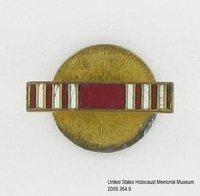
US Army Good Conduct lapel button awarded to a Czech Jewish refugee
Object
Lapel button issued to Tom T. Kovary for service in the United States Army, from 1943-1946, during World War II. On September 2, 1939, nineteen year old Tibor Kovari and his twenty year old brother, Erno, were attacked on the street for being Jewish by Nazi sympathizers in their hometown, Bratislava, Czechoslovakia. They fought back, put their attackers in the hospital, and were arrested, along with their father, Olivio. The incident received such widespread publicity that the authorities advised them to flee for fear of retaliation. They illegally crossed the border into Hungary, where they obtained visas for the US, arriving in New York on February 29, 1940. Both brothers joined the US Army: Tom was in Military Intelligence stateside; Ernest in combat, landing with the infantry on D-Day. He searched for surviving relatives, but found only one cousin, a survivor of Auschwitz death camp.
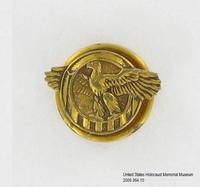
US Army Honorable Service lapel button awarded to a Czech Jewish refugee
Object
Lapel button issued to Tom T. Kovary for service in the United States Army, from 1943-1946, during World War II. On September 2, 1939, nineteen year old Tibor Kovari and his twenty year old brother, Erno, were attacked on the street for being Jewish by Nazi sympathizers in their hometown, Bratislava, Czechoslovakia. They fought back, put their attackers in the hospital, and were arrested, along with their father, Olivio. The incident received such widespread publicity that the authorities advised them to flee for fear of retaliation. They illegally crossed the border into Hungary, where they obtained visas for the US, arriving in New York on February 29, 1940. Both brothers joined the US Army: Tom was in Military Intelligence stateside; Ernest in combat, landing with the infantry on D-Day. He searched for surviving relatives, but found only one cousin, a survivor of Auschwitz death camp.

Bar Kochba Jewish Sports Club stickpin (BKB) with blue enamel decoration owned by a Czech Jewish refugee to the US
Object
Stickpin from the Bar Kochba Jewish sports club in Bratislava, Czechoslovakia, received by Tom (Tibor) Kovary, prior to his emigration to the United States. On September 2, 1939, nineteen year old Tibor Kovari and his twenty year old brother, Erno, were attacked on the street for being Jewish by Nazi sympathizers in Bratislava. They fought back, put their attackers in the hospital, and were arrested, along with their father, Olivio. The incident received such widespread publicity that the authorities advised them to flee for fear of retaliation. They illegally crossed the border into Hungary, where they obtained visas for the US, arriving in New York on February 29, 1940. Both brothers joined the US Army: Tom was in Military Intelligence stateside; Ernest in combat, landing with the infantry on D-Day. He searched for surviving relatives, but found only one cousin, a survivor of Auschwitz death camp.
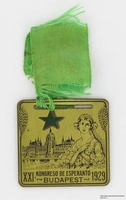
World Congress of Esperanto medallion with an image of woman and a view of Budapest owned by a Czech Jewish refugee
Object
Commemorative medal from the World Congress of Esperanto in Budapest, Hungary, in 1929, attended by Tom (Tibor) Kovary with his family. On September 2, 1939, nineteen year old Tibor Kovari and his twenty year old brother, Erno, were attacked on the street for being Jewish by Nazi sympathizers in Bratislava. They fought back, put their attackers in the hospital, and were arrested, along with their father, Olivio. The incident received such widespread publicity that the authorities advised them to flee for fear of retaliation. They illegally crossed the border into Hungary, where they obtained visas for the US, arriving in New York on February 29, 1940. Both brothers joined the US Army: Tom was in Military Intelligence stateside; Ernest in combat, landing with the infantry on D-Day. He searched for surviving relatives, but found only one cousin, a survivor of Auschwitz death camp.
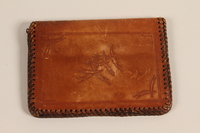
Brown leather wallet with laced edges used by a Czech Jewish refugee during his service in the US Army
Object
Wallet and passport cover used by Tom T. Kovary while a soldier in the United States Army from 1943-1946. On September 2, 1939, nineteen year old Tibor Kovari and his twenty year old brother, Erno, were attacked on the street for being Jewish by Nazi sympathizers in Bratislava. They fought back, put their attackers in the hospital, and were arrested, along with their father, Olivio. The incident received such widespread publicity that the authorities advised them to flee for fear of retaliation. They illegally crossed the border into Hungary, where they obtained visas for the US, arriving in New York on February 29, 1940. Both brothers joined the US Army: Tom was in Military Intelligence stateside; Ernest in combat, landing with the infantry on D-Day. He searched for surviving relatives, but found only one cousin, a survivor of Auschwitz death camp.
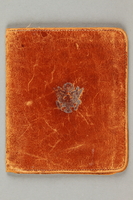
Document holder
Object
Brown leather bifold document holder with plastic covers inside. The wallet may have contained an ID card from the Office of Military Government for Germany (U.S) issued on 9 March 1946 to Ernest Kovary.
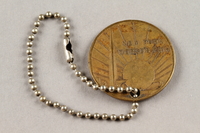
Social Security identification tag
Object
Round metal Social Security tag belonging to Ernest Kovary. The opposite side has an image of the New York World's Fair.
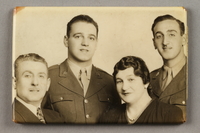
Pocket mirror with photographic image
Object
Pocket mirror with a photographic image of the Kovary family ca. 1945 on the other side.
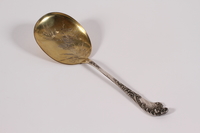
Silver ice cream serving spoon with floral engraving saved by young German Jewish refugee
Object
Silver ice cream spoon from a set of twelve brought by Ingrid Neuhaus, 18, when she was sent for safety from Hamburg, Germany, to Great Britain in Feburary 1939. She joined her younger siblings Annelore and Hans who had been sent on the Kindertransport in January. This set of spoons was the only valuable item she was able to take out of Germany.
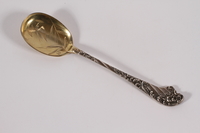
Silver ice cream spoon with floral engraving saved by young German Jewish refugee
Object
Silver ice cream spoon from a set of twelve brought by Ingrid Neuhaus, 18, when she was sent for safety from Hamburg, Germany, to Great Britain in Feburary 1939. She joined her younger siblings Annelore and Hans who had been sent on the Kindertransport in January. This set of spoons was the only valuable item she was able to take out of Germany.
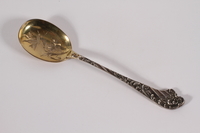
Silver ice cream spoon with floral engraving saved by young German Jewish refugee
Object
Silver ice cream spoon from a set of twelve brought by Ingrid Neuhaus, 18, when she was sent for safety from Hamburg, Germany, to Great Britain in Feburary 1939. She joined her younger siblings Annelore and Hans who had been sent on the Kindertransport in January. This set of spoons was the only valuable item she was able to take out of Germany.
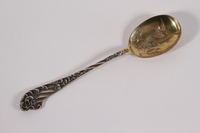
Silver ice cream spoon with floral engraving saved by young German Jewish refugee
Object
Silver ice cream spoon from a set of twelve brought by Ingrid Neuhaus, 18, when she was sent for safety from Hamburg, Germany, to Great Britain in Feburary 1939. She joined her younger siblings Annelore and Hans who had ben sent the Kindertransport in January. This set of spoons was the only valuable item she was able to take out of Germany.
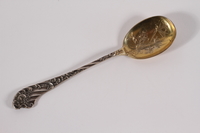
Silver ice cream spoon with floral engraving saved by young German Jewish refugee
Object
Silver ice cream spoon from a set of twelve brought by Ingrid Neuhaus, 18, when she was sent for safety from Hamburg, Germany, to Great Britain in Feburary 1939. She joined her younger siblings Annelore and Hans who had been sent on the Kindertransport in January. This set of spoons was the only valuable item she was able to take out of Germany.
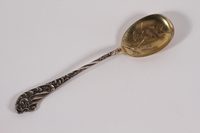
Silver ice cream spoon with floral engraving saved by young German Jewish refugee
Object
Silver ice cream spoon from a set of twelve brought by Ingrid Neuhaus, 18, when she was sent for safety from Hamburg, Germany, to Great Britain in Feburary 1939. She joined her younger siblings Annelore and Hans who had been sent on the Kindertransport in January. This set of spoons was the only valuable item she was able to take out of Germany.
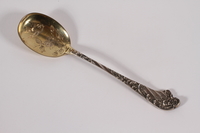
Silver ice cream spoon with floral engraving saved by young German Jewish refugee
Object
Silver ice cream spoon from a set of twelve brought by Ingrid Neuhaus, 18, when she was sent for safety from Hamburg, Germany, to Great Britain in Feburary 1939. She joined her younger siblings Annelore and Hans who had been sent on the Kindertransport in January. This set of spoons was the only valuable item she was able to take out of Germany.
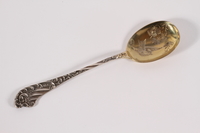
Silver ice cream spoon with floral engraving saved by young German Jewish refugee
Object
Silver ice cream spoon from a set of twelve brought by Ingrid Neuhaus, 18, when she was sent for safety from Hamburg, Germany, to Great Britain in Feburary 1939. She joined her younger siblings Annelore and Hans who had been sent on the Kindertransport in January. This set of spoons was the only valuable item she was able to take out of Germany.
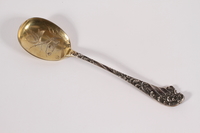
Silver ice cream spoon with floral engraving saved by young German Jewish refugee
Object
Silver ice cream spoon from a set of twelve brought by Ingrid Neuhaus, 18, when she was sent for safety from Hamburg, Germany, to Great Britain in Feburary 1939. She joined her younger siblings Annelore and Hans who had been sent on the Kindertransport in January. This set of spoons was the only valuable item she was able to take out of Germany.
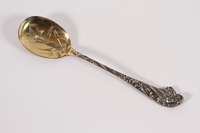
Silver ice cream spoon with floral engraving saved by young German Jewish refugee
Object
Silver ice cream spoon from a set of twelve brought by Ingrid Neuhaus, 18, when she was sent for safety from Hamburg, Germany, to Great Britain in Feburary 1939. She joined her younger siblings Annelore and Hans who had been sent on the Kindertransport in January. This set of spoons was the only valuable item she was able to take out of Germany.
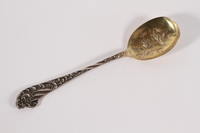
Silver ice cream spoon with floral engraving saved by young German Jewish refugee
Object
Silver ice cream spoon from a set of twelve brought by Ingrid Neuhaus, 18, when she was sent for safety from Hamburg, Germany, to Great Britain in Feburary 1939. She joined her younger siblings Annelore and Hans who had been sent on the Kindertransport in January. This set of spoons was the only valuable item she was able to take out of Germany.
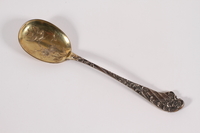
Silver ice cream spoon with floral engraving saved by young German Jewish refugee
Object
Silver ice cream spoon from a set of twelve brought by Ingrid Neuhaus, 18, when she was sent for safety from Hamburg, Germany, to Great Britain in Feburary 1939. She joined her younger siblings Annelore and Hans who had been sent on the Kindertransport in January. This set of spoons was the only valuable item she was able to take out of Germany.
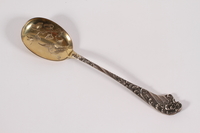
Silver ice cream spoon with floral engraving saved by young German Jewish refugee
Object
Silver ice cream spoon from a set of twelve brought by Ingrid Neuhaus, 18, when she was sent for safety from Hamburg, Germany, to Great Britain in Feburary 1939. She joined her younger siblings Annelore and Hans who had been sent on the Kindertransport in January. This set of spoons was the only valuable item she was able to take out of Germany.
Kovary and Neuhaus families papers
Document
The Kovary and Neuhaus families papers consist of biographical materials, correspondence, and photographs related to the experiences of the Kovary and Neuhaus families’ pre-World War II experiences in Czechoslovakia and Germany, respectively; their emigration due to antisemitic persecution; their immigration to the United States and Great Britain; and subsequent experiences during World War II and in the immediate post-war years. The collection also includes restitution files documenting Ernest Kovary’s work assisting Holocaust survivors in filing restitution claims. Neuhaus family materials include biographical materials, correspondence, and photographs. Biographical materials document Ingrid’s immigration to Great Britain on a Kindertransport in 1939 and include her wartime diaries and a memoir she wrote in the 1990s. Correspondence files include Ingrid’s correspondence with her parents, who were killed in the Holocaust. This series also includes extensive pre-war, wartime, and post-war photographs of Ingrid Neuhaus Kovary and her family. Kovary family materials include biographical materials, correspondence, photographs, and printed materials documenting the Kovary family before, during, and after World War II. Biographical materials include birth, marriage, and death certificates; immigration documents; and documents pertaining to Olivio Kovary's repeated attempts to certify his American citizenship. Family correspondence primarily dates from the World War II years and includes many letters written in Esperanto. Photographs depict much of the Kovary family. Printed materials document the family’s interest in Esperanto. Restitution files include correspondence, forms, and notes documenting Ernest Kovary’s work as a notary public assisting Holocaust survivors in filing restitution claims.


